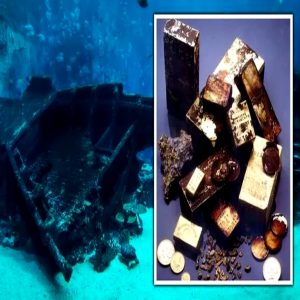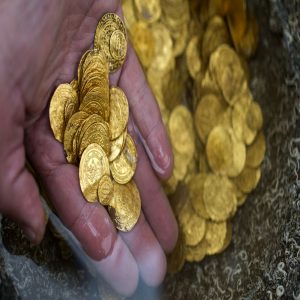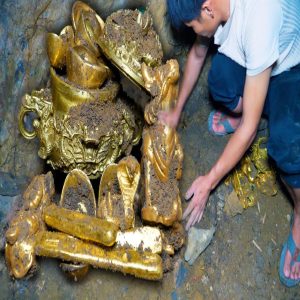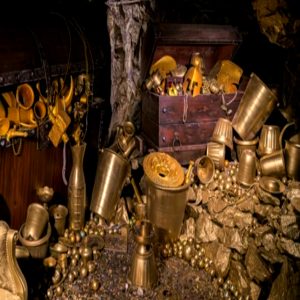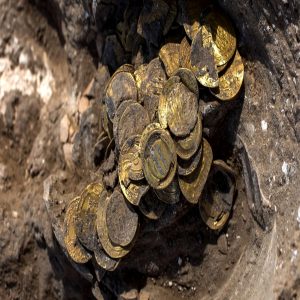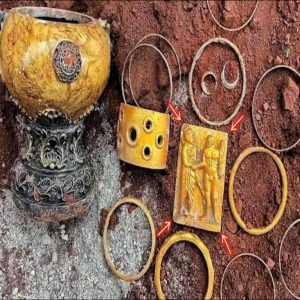Two decades ago, an amateur archaeologist discovered the fractured pieces of a 2,000-year-old Roman helmet in England, kicking off an intensive restoration project.

Harborough MuseumA replica of the Hallaton Helmet.
In 2001, an amateur archaeologist discovered the severely damaged remains of a 2,000-year-old Roman helmet in the English countryside.
Now, two decades of research and restoration later, the ornate helmet is on display, providing viewers with a fascinating glimpse into Roman British history.
Discovering The Helmet In The Countryside
In 2000, Ken Wallace, an amateur archaeologist from the Hallaton Fieldwork Group, was exploring a site in Leicestershire, England when he stumbled upon a hoard of coins and other Iron Age treasures. Realizing he had something big on his hands, he called in the British Museum and Leicester University to conduct a proper excavation of the site.
A year later, Wallace uncovered an unassuming brown clump at the site. Archaeologists joked at the time that it resembled a “rusty bucket,” according to the Miami Herald. However, further examination revealed that the clump was no bucket, but rather a 2,000-year-old Roman calvary helmet decorated with gold and silver motifs.
The researchers also identified other items buried with the helmet, including several gold coins and pig bones. Given the placement of these items, they believe this was the site of a native British shrine.
Analyzing The Hallaton Helmet

Harborough MuseumThe helmet on display at the Harborough Museum in England.
Now known as the Hallaton Helmet, this object was likely worn by a high-ranking Roman cavalry officer around the year 43 B.C.E., making it one of the oldest Roman helmets ever found.
According to the Harborough Museum, where the helmet now resides, a careful examination of the helmet revealed that it was made of layers of iron and thin silver. Adorned with gold leaf, the ornate helmet was decorated with elaborate designs of wreaths, lions, and the goddess Victory.
Interestingly, the helmet also appears to feature the figure of a Briton cowering beneath the hooves of a Roman emperor’s horse, posing questions about the two groups’ relationship in this region.
Some scholars, like Dr. Jeremy Hill of the British Museum, suspect that the helmet is evidence that some Britons fought for the Romans, given that it was likely a Briton who ceremoniously buried the helmet.
“We normally think of the Roman conquest of Britain as Romans versus us,” Hill told the BBC. “Here you probably have a situation where local Britons are fighting on the Roman side.”
Other scholars are not so sure, writing that the helmet could have been a trophy of war or even a diplomatic gift. Either way, the helmet poses important questions to scholars for future research.
Bringing The Past Back To Life
By the time researchers found the helmet, time and corrosion had separated it into thousands of pieces. Unfortunately, this meant that researchers could not simply pull it from the ground. Instead, experts lifted it in a massive block of soil and painstakingly excavated the pieces in a laboratory.
After the helmet’s reassembly was finally complete in 2012, researchers were tasked with refurbishing it.
The restoration team decided to create a 3D scan of the helmet to get a better idea of its shape and detail. With this information, the team commissioned two replica helmets to explore how the original may have looked in its heyday.
Work on the original helmet continued, and eventually, the Leicestershire County Council raised £1 million to buy the entire Hallaton collection and put it on display in the Harborough Museum. Now in its new resting place, the helmet is 80% complete.
“There has also been a lot of behind the scenes work from the staff in the Museum Service, who have created lots of content to tell the story of the helmet and its discovery,” Christine Radford, a councilor for the Leicestershire County Council, said in a press release. “I do hope you all get the chance to head down to the museum, to experience this historic artifact.”
